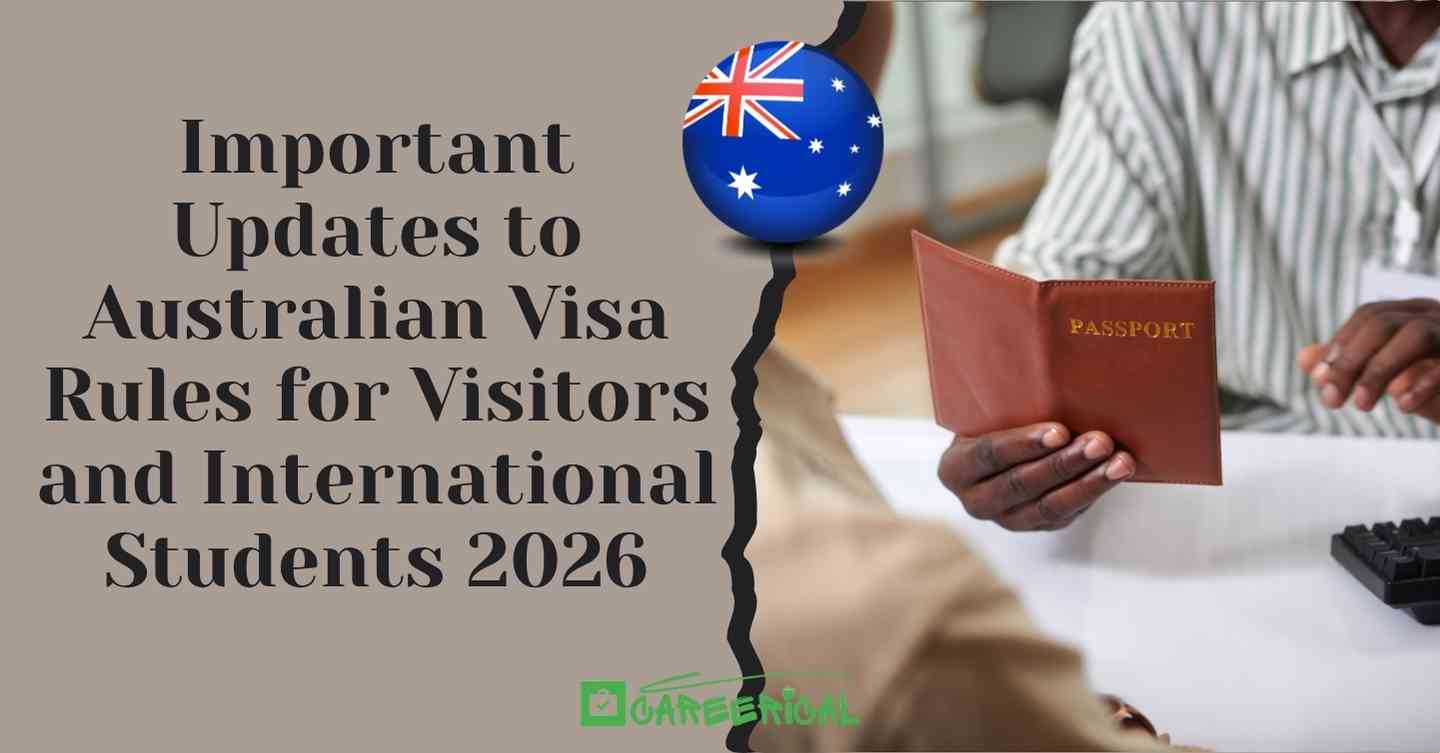Important Updates to Australian Visa Rules for Visitors and International Students 2026
Every year brings fresh changes to visa policies, and 2026 is no exception for Australia. Whether you’re planning a visit or preparing to study, it’s essential to stay informed about the latest visa rules from Department of Home Affairs that affect both visitors and international students. In this post, we’ll break down the most important updates, explain what they mean for you, and offer practical advice to navigate the changes smoothly.
1. Visitor Visa: Key Changes to Be Aware Of
Even short-term visits to Australia are affected by updated regulations. Two major changes for visitor visas include:
A) Application Charges and Fee Increases
From 1 July 2025, the visa application charge (VAC) for certain visa subclasses—including those used by international students and some visitor-related categories—were increased.
While the increase primarily impacts student visas, it highlights that cost ceiling risks apply to others as well. If you’re applying as a visitor, always check the current VAC to avoid surprises.
B) Stricter Intent & Duration Rules
There is growing scrutiny over the “genuine visitor” condition—that is, showing you intend a short stay and will leave at the end of your visit. For instance, if you hold a visitor visa and then apply for a student or other longer-term visa while in Australia, you may face complications or be required to apply from overseas.
This means if your visit plan is straightforward tourism or family visit, ensure your documents clearly reflect that. If you’re considering staying on as a student or long-term visitor, talk with a professional or check guidance first.
2. Student Visas: Major Shifts for 2026 Applicants
For international students planning to study in Australia, the changes are more substantial. If you’re applying (or will apply) for a Student visa (Subclass 500) or related pathways in 2026, check the following updates carefully:
A) Higher National Planning Level (NPL) for Student Enrolments
The Australian Government has announced that for the 2026 year the National Planning Level (NPL) for new international student commencements will rise to 295,000—an increase of 25,000 compared to earlier years.
What this means: more new student places are available across universities and vocational providers. But: this is not a guarantee of visa approval—eligibility rules, provider integrity, and visa compliance remain critical.
B) Expanded English Language Test Options
On 7 August 2025, Home Affairs announced that nine English Language Tests (ELTs) are now accepted for student and other visa purposes—giving applicants more choice and flexibility.
This is a positive change. If your preferred English test wasn’t accepted before, you may now have additional options. Double-check which tests your provider or visa subclass accepts.
Recommended for you:
Comparing Visitor Visa, Work Permit, and Study Permit in Canada: Which Is Easier?
Steps to Change a Canadian Visitor Visa to a Work Permit
How to Seamlessly Convert Your Visitor Visa to a Work Permit in Canada
C) Processing Priority Rules & Provider Thresholds
Students applying from overseas (offshore) will have their visa priority determined by whether their provider has reached a set quotas/thresholds (under Ministerial Direction No. 111).
What this means for you:
- If your provider is under threshold → your application may get “Priority 1 – High” processing (faster).
- If provider has reached threshold → “Priority 2 – Standard”.
Hence it’s wise to check your provider’s status and act early.
D) Fee Increases & Financial Capacity
Student visa charges have risen. According to official news, the application charge for primary Student visas increased as of 1 July 2025.
Also, there’s heightened monitoring of student visa applicants’ ability to pay tuition, living costs and genuine intention to study.
If you’re budgeting, factor in not only tuition, but visa costs, health cover, living expenses and potential fee hikes.
3. What These Changes Mean for You — Visitor vs Student
Here’s how to interpret and act on these updates based on your goal:
- You’re a visitor:
- Double-check your visitor visa subclass and current charges before applying.
- Be prepared to clearly demonstrate you intend only to visit and will depart at end of stay.
- Avoid planning to switch to a student or longer stay visa while in Australia unless permitted and you meet criteria (some changes restrict this).
- You’re an international student:
- Choose a provider that is eligible and check if it has reached its threshold (for priority processing).
- Confirm your English test is accepted and complete tasks early.
- Budget for increased visa application charges and supporting costs (health cover, living costs).
- Lodge your application early to meet processing priorities and avoid being caught in a slower queue.
- Watch for provider integrity: Australia is increasing oversight of education providers to ensure compliance.
4. Practical Steps to Prepare Now
- Visit official sources: Check the Department of Home Affairs’ website and the Student Australia “News” section.
- Select your provider carefully: Confirm it is registered, in good standing, meets student integrity standards and has capacity under NPL.
- Complete required English test early: With nine tests now accepted, you have more flexibility—book early.
- Prepare financial evidence: Make sure you have funds for tuition, living costs, health cover, and visa fees.
- Apply early if offshore: Submitting your visa application early increases chance of being processed under Priority 1 if provider status allows.
- Keep visitor/study goals separate: If you’re first visiting and then considering study, treat each goal independently and ensure you meet the correct criteria for each.
FAQs
Q: Does the NPL (295,000 student places) mean a cap and fewer visas?
A: No. The NPL is a planning level, not an absolute cap. It helps the government to manage growth responsibly. Even if a provider is under threshold, you can still apply—though processing priority may vary.
Q: Which English tests are now accepted for student visas?
A: The Home Affairs update states that nine different ELTs are accepted. You should check the official list and confirm your test is among them.
Q: Can I apply for a Student visa while in Australia on a visitor visa?
A: This has become more complex. For many cases, you’ll be required to apply from outside Australia, or you risk rejection on the grounds of lack of genuine intention.
Q: Are visa application fees guaranteed not to increase further?
A: No. Fees for visas (especially student visas) have already increased, and further adjustments are possible. Always check latest charges before applying.
Q: What happens if my education provider has already reached its threshold?
A: Your application may be processed under “Priority 2 – Standard,” meaning it may take longer. But it does not mean your visa will be refused just because of that.
Final Thoughts
The 2026 visa rule updates for Australia underscore one message: be prepared, apply early, and choose wisely. Whether you’re visiting or applying as an international student, you’ll benefit by staying informed, confirming eligibility, and managing your application proactively.
For visitors, clarity of intent and timing remain key. For students, increased intake opportunities, more flexible English testing and provider-based prioritisation bring real benefits — if you act with foresight. Check official sources, confirm provider status, set aside adequate budget, and plan your visa journey now to make the most of Australia’s 2026 changes.
More Opportunities:

